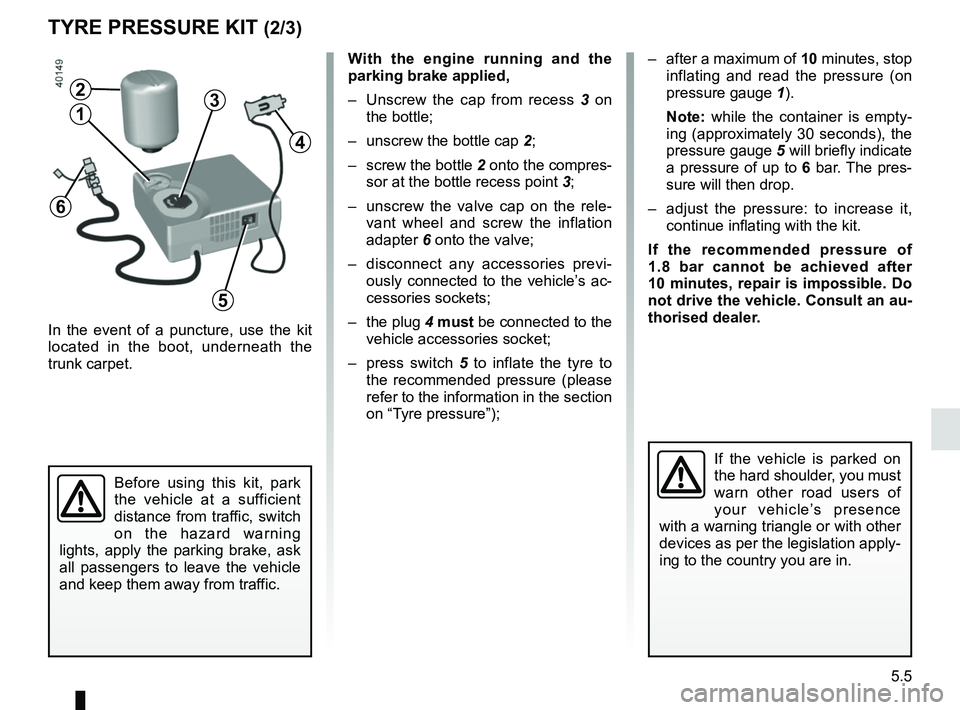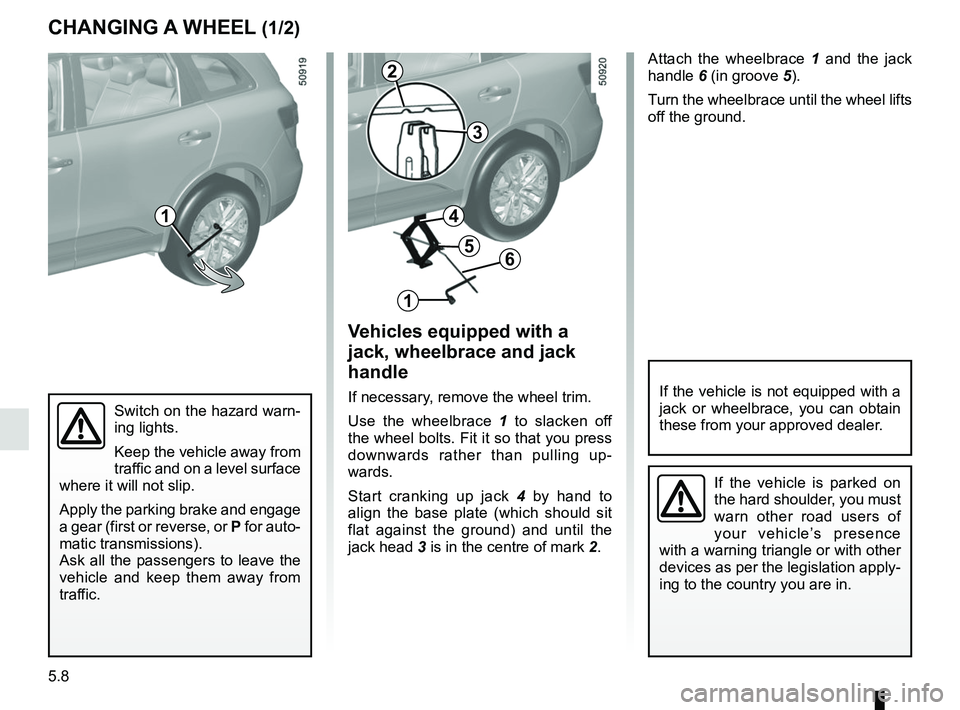2018 RENAULT KOLEOS warning light
[x] Cancel search: warning lightPage 269 of 332

5.5
TYRE PRESSURE KIT (2/3)
In the event of a puncture, use the kit
located in the boot, underneath the
trunk carpet.
With the engine running and the
parking brake applied,
– Unscrew the cap from recess 3 on
the bottle;
– unscrew the bottle cap 2;
– screw the bottle 2 onto the compres- sor at the bottle recess point 3;
– unscrew the valve cap on the rele- vant wheel and screw the inflation
adapter 6 onto the valve;
– disconnect any accessories previ- ously connected to the vehicle’s ac-
cessories sockets;
– the plug 4 must be connected to the
vehicle accessories socket;
– press switch 5 to inflate the tyre to
the recommended pressure (please
refer to the information in the section
on “Tyre pressure”);
Before using this kit, park
the vehicle at a sufficient
distance from traffic, switch
on the hazard warning
lights, apply the parking brake, ask
all passengers to leave the vehicle
and keep them away from traffic.
If the vehicle is parked on
the hard shoulder, you must
warn other road users of
your vehicle’s presence
with a warning triangle or with other
devices as per the legislation apply-
ing to the country you are in.
– after a maximum of 10 minutes, stop inflating and read the pressure (on
pressure gauge 1).
Note: while the container is empty-
ing (approximately 30 seconds), the
pressure gauge 5 will briefly indicate
a pressure of up to 6 bar. The pres-
sure will then drop.
– adjust the pressure: to increase it, continue inflating with the kit.
If the recommended pressure of
1.8 bar cannot be achieved after
10 minutes, repair is impossible. Do
not drive the vehicle. Consult an au-
thorised dealer.
4
2
13
5
6
Page 272 of 332

5.8
Attach the wheelbrace 1 and the jack
handle 6 (in groove 5).
Turn the wheelbrace until the wheel lifts
off the ground.
Switch on the hazard warn-
ing lights.
Keep the vehicle away from
traffic and on a level surface
where it will not slip.
Apply the parking brake and engage
a gear (first or reverse, or P for auto-
matic transmissions).
Ask all the passengers to leave the
vehicle and keep them away from
traffic.
CHANGING A WHEEL (1/2)
Vehicles equipped with a
jack, wheelbrace and jack
handle
If necessary, remove the wheel trim.
Use the wheelbrace 1 to slacken off
the wheel bolts. Fit it so that you press
downwards rather than pulling up-
wards.
Start cranking up jack 4 by hand to
align the base plate (which should sit
flat against the ground) and until the
jack head 3 is in the centre of mark 2.If the vehicle is not equipped with a
jack or wheelbrace, you can obtain
these from your approved dealer.
If the vehicle is parked on
the hard shoulder, you must
warn other road users of
your vehicle’s presence
with a warning triangle or with other
devices as per the legislation apply-
ing to the country you are in.
1
2
3
1
6
4
5
Page 275 of 332

5.11
TYRES (2/3)
Tyre pressures
Adhere to the tyre pressures (including
the emergency spare wheel). The tyre
pressures should be checked at least
once a month and additionally before
any long journey (refer to the label af-
fixed to the edge of the driver’s door).The pressures should be checked cold:
ignore higher pressures which may be
reached in hot weather or following a
high speed journey.
If the tyre pressures cannot be checked
when the tyres are
cold, increase the
pressures from 0.2 to 0.3 bar (or 3 PSI).
Never deflate a hot tyre.
Special note
Depending on the vehicle, there may
be an adapter which needs to be posi-
tioned on the valve before air is added. Vehicle fitted with a tyre pressure
monitoring system
In cases of under-inflation (puncture,
low pressure, etc.), warning light
lights up on the instrument panel.
Please refer to the information on the
“Tyre pressure monitoring system” in
Section 2.
Emergency spare wheel
Refer to the information on “Puncture”
and “Changing a wheel” in Section 5.
Incorrect tyre pressures
lead to abnormal tyre wear
and unusually hot running.
These are factors which
may seriously affect safety and lead
to:
– poor road holding,
– risk of bursting or tread separa- tion.
The pressure depends on the load
and the speed of use. Adjust the
pressure according to the condi-
tions of use (refer to the label affixed
to the edge of the driver’s door).
Please be aware that a
poorly tightened or miss-
ing valve cap can make the
tyres less airtight and lead
to pressure loss.
Always use valve caps identical to
those fitted originally and tighten
them fully.
Page 289 of 332

5.25
FUSES (3/3)
Allocation of fuses
(the presence of certain fuses depends on the vehicle equipment level)\
Symbol Allocation Symbol AllocationSymbol Allocation
BLOWER Ventilation VDCVehicle dynamic
control H/MIRR Heated door mirrors
TURN
HAZARD Hazard lamp
STOP LAMP Stop lamp HEATER
SEAT Heater seat
2ND
POWER
SOCKET 2nd power socket
POWER
DR LOCK2 Power door lock EC AUTO
ACC Air conditioner control
unit
REAR
WIPER Rear wiper CIGAR
LIGHTER Cigar lighter REAR
VIEW Rear view mirror
POWER
DR LOCK Power door lock HEAT
STEER
WHEEL Heat steering wheel
WASH
MTR Washer motor
ELEC B, B2 Electrical equipment RR DEFElectrically defrosted
rear window GEAR BOX
OIL PUMP Gear box oil pump
IMOB Immobilizer BOSE Bose amp BCM Body control module
AUDIO Audio ACC RADIOAccessory socket,
radio POWER
WINDOW Power window
ABS/EPS Anti lock brake system JUNCTION
MODULE Junction module SEAT BELT
WARNING Seat belt warning
module
MEDIA Multimedia equipment AIR CON Air condition control
unitSTRG
WHEEL ANGLE Steering wheel angle
sensor
Page 302 of 332

5.38
OPERATING FAULTS (4/7)
On the roadPOSSIBLE CAUSESWHAT TO DO
Vibrations. Tyres not inflated to correct pres-
sures, incorrectly balanced or dam-
aged. Check the tyre pressures: if this is not the
problem, have them checked by an ap-
proved Dealer.
White smoke from the exhaust. In the diesel version, this is necessar-
ily a fault. Smoke may be caused by
particle filter regeneration. Please refer to the information on “Special
features of diesel versions” in Section 2.
Smoke under the bonnet. Short-circuit or cooling system leak. Stop, switch off the ignition, stand away
from the vehicle and contact an approved
dealer.
The oil pressure warning light comes
on: while cornering or braking The level is too low. Top up the engine oil level (refer to the in-
formation on “Engine oil level: topping up,
filling” in Section 4).
is slow to go out or remains lit
under acceleration Loss of oil pressure.
Stop the vehicle and contact an approved
Dealer.
Page 303 of 332

5.39
OPERATING FAULTS (5/7)
On the roadPOSSIBLE CAUSESWHAT TO DO
Steering becomes heavy. Assistance overheating.
Fault with the electric assistance
motor.
Fault in assistance system. Drive carefully at reduced speed, be aware
of the level of force in the steering wheel
needed to turn the wheels. Consult an ap-
proved dealer.
The engine is overheating. The cool-
ant temperature indicator is in the
warning zone and warning light
® comes on. Engine cooling fan not working. Stop the vehicle, switch off the engine and
contact an approved dealer.
Coolant leaks. Check the coolant reservoir: it should con- tain fluid. If there is no coolant, consult an
approved dealer as soon as possible.
Coolant boiling in the coolant reser-
voir. Mechanical fault: damaged cylinder
head gasket. Stop the engine.
Contact an approved dealer.
Radiator:
If there is a significant lack of coolant, remember that it must never b\
e topped up using cold coolant while
the engine is very warm. After any procedure on the vehicle which has involved even partial drain\
ing of the cooling
system, it must be refilled with a new mixture prepared in the correct p\
roportions. Reminder: only products approved
by our Technical Department may be used for this purpose.
Page 325 of 332

7.1
ALPHABETICAL INDEX (1/5)
A
ABS ..............................................................1.56, 2.31 → 2.34
accessories........................................................................\
5.28
accessories socket ............................................................ 3.31
adaptive cruise control...........................................2.69 → 2.76
additional methods of restraint .......................................... 1.33 side protection ............................................................. 1.32
to the front seat belts .......................................1.27 → 1.30
to the rear seat belts .................................................... 1.31
adjusting your driving position ..1.19 – 1.20, 1.23 → 1.26, 3.32
advice on antipollution ....................................................... 2.26
air bag...........................................................1.27 → 1.33, 1.54
activating the front passenger air bags ........................ 1.49
deactivating the front passenger air bags .................... 1.47
air conditioning ........................................................3.4 → 3.17
air vents ...................................................................... 3.2 – 3.3
anti-corrosion check ..............................................6.14 → 6.18
anti-corrosion protection .................................................... 4.15
anti-lock braking system: ABS ...............................2.31 → 2.34
antipollution advice .................................................................\
......... 2.26
armrest: front ..................................................................\
............ 3.27
ashtray ................................................................\
............... 3.31
ASR (traction control) ............................................2.31 → 2.34
assisted parking.....................................................2.84 → 2.89
audible and visual signals.................................................. 1.84
automatic gearbox (use) ........................................2.90 → 2.92
automatic gearbox selector lever...........................2.90 → 2.92
automatic trunk lid .................................................3.37 → 3.41
B
battery................................................. 4.13 – 4.14, 5.26 – 5.27 troubleshooting ................................................. 5.26 – 5.27
battery (remote control) ..................................................... 5.22
blind spot warning signal .......................................2.55 → 2.58blind spot: warning signal ......................................2.55
→ 2.58
bonnet........................................................................\
. 4.2 – 4.3
brake fluid ........................................................................\
.... 4.9
bulbs changing ..........................................................5.13 → 5.20
C
catalytic converter................................................... 2.14 – 2.15
central door locking ........................1.2 – 1.3, 1.7 → 1.13, 1.16
changing a bulb .....................................................5.13 → 5.20
changing a wheel........................................................ 5.8 – 5.9
changing gear ...............................................2.16, 2.90 → 2.92
child restraint/seat ....................1.34 – 1.35, 1.37 → 1.43, 1.47
child safety...............1.30, 1.34 – 1.35, 1.37 → 1.43, 1.47, 2.5,
3.19 – 3.20
child seats..........................................1.34 – 1.35, 1.37 → 1.43
children ........................................ 1.5, 1.34 – 1.35, 3.19 – 3.20
children (safety) ................................................................... 1.5
cigar lighter ........................................................................\
3.31
cleaning: inside the vehicle .............................................. 4.17 – 4.18
clock ..................................................................\
................ 1.76
closing the doors ................................................... 1.11 → 1.16
control instruments .......................................1.54 → 1.63, 1.76
controls ...............................................................\
...1.50 → 1.53
courtesy light ................................................3.23 → 3.25, 5.19
courtesy mirrors ................................................................. 3.26
cruise control ................................................1.57, 2.65 → 2.68
cruise control-speed limiter....................................2.62 → 2.68
customised vehicle settings ................................... 1.72 – 1.73
customising the vehicle settings ............................ 1.72 – 1.73
D
dashboard..............................................................1.50 →
1.53
demisting rear screen ...........................................................3.4 → 3.6
Page 327 of 332

7.3
ALPHABETICAL INDEX (3/5)
G
gear lever........................................................................\
... 2.16
H
hands-free telephone integrated control ................. 3.49 – 3.50
hazard warning lights signal .............................................. 1.84
headlight beam adjustment .................................... 1.85 – 1.86
headrest.................................................................... 1.19, 3.32
heated seats ............................................................. 1.20, 1.22
heating and air conditioning system .................3.4 → 3.6, 3.17
heating system ........................................................3.4 → 3.17
Hill Start Assist.......................................................2.31 → 2.34
horn ...................................................................\
................ 1.84
horn: flash ..................................................................\
........... 1.84
hubcap tool ........................................................................\
.. 5.7
I
ignition switch ...................................................................... 2.3
indicators ......................................................1.84, 5.13 → 5.18
indicators: direction indicators ....................................................... 1.84
instrument panel ..............................................1.54 → 1.63
instrument panel ....................................................1.54 → 1.71
instrument panel messages...................................1.62 → 1.71
interior trim maintenance ..................................................... 4.17 – 4.18
Isofix ....................................................................... 1.37 – 1.38
J
jack ...................................................................\
................... 5.7
K
keys ...................................................................\
........1.2 → 1.4L
lane departure warning ..........................................2.50
→ 2.52
levels .................................................................\
......4.8 → 4.10
levels: brake fluid ...................................................................... 4.9
coolant ................................................................\
........... 4.8
windscreen washer reservoir ....................................... 4.10
lifting the vehicle changing a wheel .................................................. 5.8 – 5.9
lighting: exterior .............................................................1.79 → 1.86
instrument panel .......................................................... 1.79
interior ..........................................3.23 → 3.25, 5.19 – 5.20
lights adjustment ........................................................ 1.85 – 1.86
changing bulbs .................................................5.13 → 5.15
front ..................................................................\
5.13 → 5.15
lights: adjusting ........................................................... 1.85 – 1.86
brake lights ......................................................5.16 → 5.18
dipped beam headlights .................1.54, 1.79, 5.13 → 5.15
direction indicators .........................1.54, 1.84, 5.13 → 5.16
fog lights .................................................... 1.54, 1.81, 5.18
hazard warning ............................................................ 1.84
main beam headlights ................................ 1.54, 1.79, 5.13
reversing lights ............................................................. 5.18
side lights ................................................1.79, 5.13 → 5.16
load permitted on the roof.................................................... 6.6
locking the doors .....................................................1.4 → 1.16
luggage compartment cover .............................................. 3.42
M
maintenance ............................................................\
.......... 2.26
maintenance: bodywork .......................................................... 4.15 – 4.16
interior trim ........................................................ 4.17 – 4.18